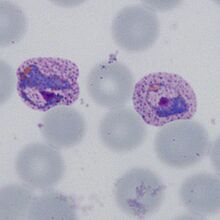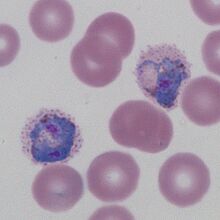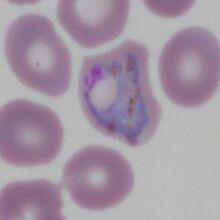Staining pH: Difference between revisions
From haematologyetc.co.uk
(Created page with "---- '''Navigation'''</br> Go Back ---- {| class="wikitable" style="border-style: solid; border-width: 4px; color:black" |colspan="1" style = "font-size:100%; color:black; background: FFFAFA"|<span style="color:navy>'''Why is there an optimal pH for malaria evaluation?'''</span> <gallery mode="nolines" widths="220px" heights="220px" > File:PHcorrect.jpg|A|link={{filepath:|PHcorrect.jpg}} File:PHincorrect.jpg|A|link={{filepath:|PHincor...") |
No edit summary |
||
| (One intermediate revision by the same user not shown) | |||
| Line 10: | Line 10: | ||
<gallery mode="nolines" widths="220px" heights="220px" > | <gallery mode="nolines" widths="220px" heights="220px" > | ||
File:PHcorrect.jpg|A|link={{filepath:|PHcorrect.jpg}} | File:PHcorrect.jpg|A|link={{filepath:|PHcorrect.jpg}} | ||
File:PHincorrect.jpg| | File:PHincorrect.jpg|B|link={{filepath:|PHincorrect.jpg}} | ||
File:PHincorrect2.jpg|C|link={{filepath:|PHincorrect2.jpg}} | |||
</gallery> | </gallery> | ||
Trophozoites of ''P.vivax'' stained at pH7.4 (A) or pH6.9 (B). Note that staining at the more alkaline conditions (pH7.4) gives the red cell a pale blue colour when compared to the acidic conditions (pH6.9), with these conditions making both the trophozoite and the added cytoplasmic dots more visible | Trophozoites of ''P.vivax'' stained at pH7.4 (A) or pH6.9 (B ad C). Note that staining at the more alkaline conditions (pH7.4) gives the red cell a pale blue colour when compared to the acidic conditions (pH6.9), with these conditions making both the trophozoite and the added cytoplasmic dots more visible. Where pH7.4 is used the key features of parasite shape and red cell morphology can still be seen, but parasites are less evident and dots may be fainter (B) or absent (C). | ||
---- | ---- | ||
Latest revision as of 12:57, 6 June 2024
Navigation
Go Back
| Why is there an optimal pH for malaria evaluation?
Trophozoites of P.vivax stained at pH7.4 (A) or pH6.9 (B ad C). Note that staining at the more alkaline conditions (pH7.4) gives the red cell a pale blue colour when compared to the acidic conditions (pH6.9), with these conditions making both the trophozoite and the added cytoplasmic dots more visible. Where pH7.4 is used the key features of parasite shape and red cell morphology can still be seen, but parasites are less evident and dots may be fainter (B) or absent (C). Description
|


